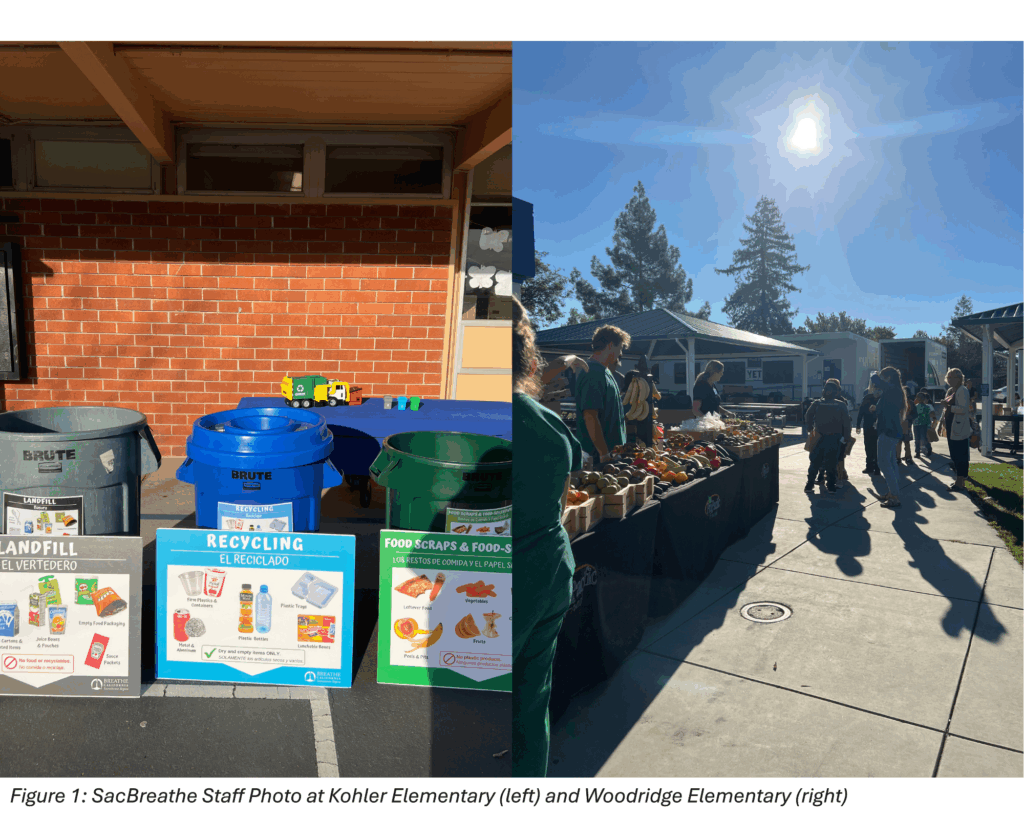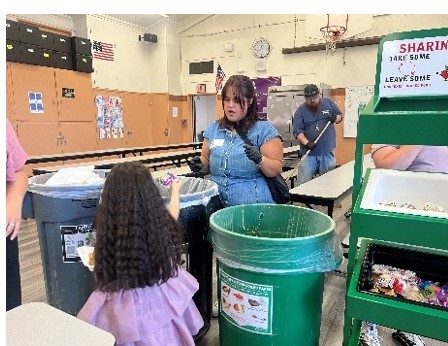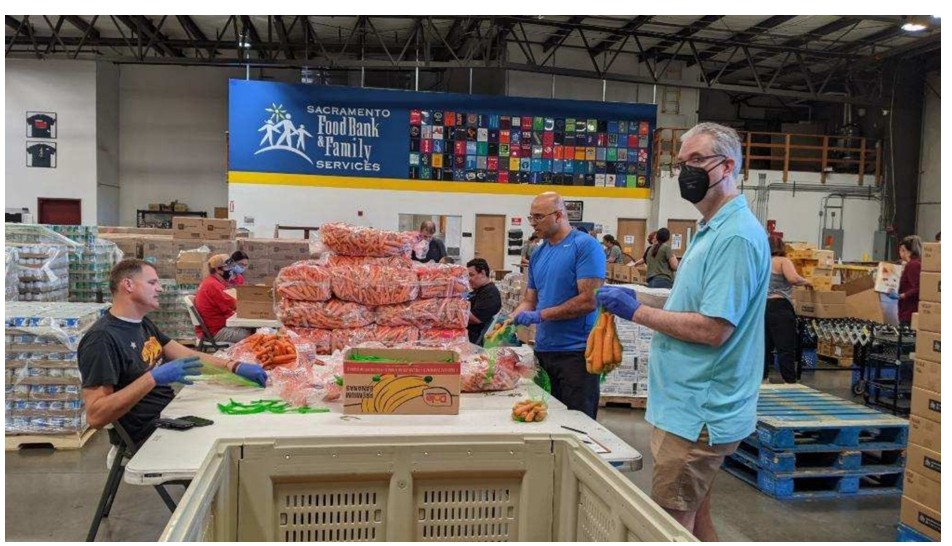
The Cost of Federal Funding Cuts Part 1
The Cost of Federal Funding Cuts: Public Health, Air Quality, and the Future
Across the country, schools, food banks, and community-based programs are dealing with major federal funding cuts. These programs have helped schools and food banks source local, fresh food to keep communities connected to their food systems. Without federal funding, these programs will cease to exist, and students, families, and local farmers will feel the impact. When access to local and sustainable food is lost, the climate will also face consequences. Local food and farming reduce the need for long-haul transportation, cuts packaging waste, and supports school organics recycling programs that teach students how to correctly sort their waste.
In particular, federal funding helps establish programs that promote food literacy, reduce waste, and support long-term sustainability goals of SB 1383, which mandates a 75% reduction in organic waste sent to landfills. When schools can no longer run composting or food recovery programs, food and compostable waste ends up in landfills, increasing methane emissions.
In Twin Rivers Unified School District (TRUSD), programs like the Farm to School Implementation Grant and the USDA Fresh Fruit and Vegetable Program build a foundation of food literacy and environmental awareness. These programs give students direct access to fresh produce and introduce them to the nutritional value of food. Many students get the chance to try fresh fruits and vegetables they may not have access to at home. These programs also introduce waste sorting, food recovery and share carts into schools.

For example, SacBreathe’s Food Scraps & Recycling Program teaches students the importance of reducing food waste by introducing share carts to collect perfectly edible food that would have otherwise gone to waste, while placing inedible food scraps in the organics bin. Nutritional Service’s Team Lead Nora Guiterrez has noted that “Since kids have access to more food as snacks, their bellies are fuller, which in turn means more energy for them to pay attention in class.” Students are learning to reduce food waste by sharing and composting what they cannot share, ensuring that those who need more food have access to it.
However, without resources to invest in nutrition education, waste station infrastructure, and the training of staff to teach these systems, schools lose the ability to teach food literacy and combat climate change. As a result, more food will end up in landfills, methane emissions will increase, and our air quality will decline.

Recently, USDA cut two federal programs, resulting in a $1 billion cut in funding to schools and food banks purchasing food directly from local farms, ranchers and producers. This includes $660 million from the Local Food for Schools program (impacting 40 U.S. States) and $420 million for a Local Food Purchase Assistance Cooperative Agreement. This impacts several key communities, like the schools that budgeted these funds for the 2025-26 school year and now must scramble to revise their food budgets and secure alternative food sources. These programs supported schools in offering fresher, healthier meals, helping to build trust in school nutrition programs and reinforcing the district’s commitment to student well-being. Without these funds, students will lose access to fresh, local meat and produce. At the same time, farmers will lose a significant source of income. Food shelters that relied on this funding will also struggle to provide fresh, nutritious produce to their communities.
This loss of funding is concerning because reduced access to local food worsens air quality by increasing reliance on freight transported foods from across the country. For example, Sacramento schools receiving food from local farms benefit from low food mileage. Adding barriers to local food access increases transportation distances, raising emissions and complicating efforts to reduce carbon pollution.
Currently, a budget reconciliation bill threatens to impose the largest single cut to the Federal Supplemental Nutrition Assistance Program (SNAP) in the program’s history. With this bill, SNAP will face a 25% reduction in funding over the next ten years. This will impact the forty-two million low-income Americans who rely on it for access to fresh and affordable food. Of those affected, over ten million are Hispanic, including five million children, highlighting the disproportionate impact on this community.
Locally, 249,000 people in Sacramento County rely on CalFresh, the California extension of the SNAP program. Since CalFresh is 99% funded by SNAP, the proposed cuts would shift approximately $1 billion in costs onto the state to maintain current service levels for those who need it most.
The SNAP program is an important tool for reducing reliance on overly processed foods. Leaning towards healthier produce available through the program’s funding encourages farmers to pursue crop diversification, which encourages ecological benefits. Heavily processed foods are energy-intensive to produce and can increase greenhouse gas (GHG) emissions. More reliance on plastic wrapped processed foods can inhibit progress for bills like SB 1383 that want to reduce emissions from organic waste in landfills. Since plastic packaging for processed foods may still have food in it when the consumer is finished, it will often lead to getting thrown away into landfill trash cans instead of being separated into the food scraps bin due to convenience. This will lead to organic waste rotting in landfills and increasing methane gas emissions which can ruin air quality. Ultimately, funding cuts to programs like the Farm to School Implementation Grant and the USDA’s Fresh Fruit and Vegetable program pose a risk to food literacy, environmental responsibility, and the promotion of lifelong healthy habits. Without adequate funding, school districts throughout the Sacramento region will be forced to scale back food recovery and composting efforts, undermining the goals of SB 1383 objectives and slowing the progress toward reducing organic waste in landfills. Similarly, local food banks and shelters are being pushed to their limits, making it increasingly difficult for communities to manage surplus food efficiently or meet the needs of food-insecure families through CalFresh and SNAP programs.

To protect the future, local education agencies need reliable funding to support the social and physical infrastructure that enables sustainable food systems. This means investing in nutrition education in the classroom, proper waste separation stations within school cafeterias, composting bins at schools, and the trained staff to manage and sustain these long-term efforts. The loss of funding will not only lead to an increased concentration of compostable materials in landfills, but it will also lead to increased methane emissions and worsening air quality, with long-term consequences for lung health in already vulnerable communities. We must advocate for the restoration and expansion of funding to keep these necessary programs alive so we can continue to build a healthier and more sustainable future for all.
Authors: Sharon Kaur, Melissa Hill, Paige Arnett, Kassandra Vega, Shivam Gandhi